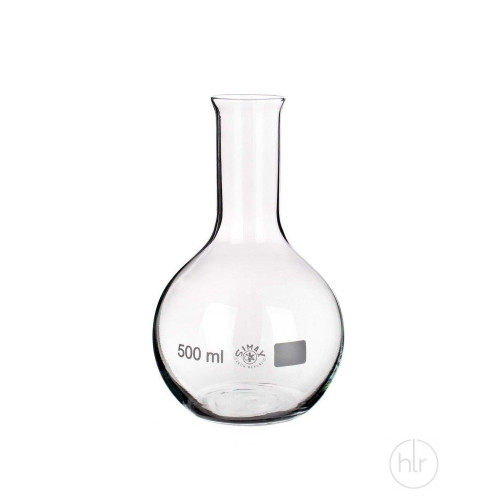Boiling Flask,flat bottom
Technical Specifications
Material: Borosilicate Glass
Capacity: Available in various sizes ranging from 50 ml to 2000 ml
Neck Size: Standard taper sizes for compatibility with laboratory stoppers and condensers
Temperature Range: Can withstand temperatures up to 500°C
Dimensions: Varies by capacity, with standardized neck diameters
Weight: Varies by capacity, designed for ease of handling
Color: Transparent for easy observation of contents
Graduations: Marked for approximate volume measurement
available soon
Flat Bottom Boiling Flasks: The Self-Supporting Workhorses of Bench Chemistry
I've watched too many colleagues struggle with round-bottom flasks that need three pieces of support equipment just to stay upright. Flat bottom boiling flasks changed how I approach routine heating—you literally place them on the hotplate and start your reaction.
No clamps, no cork rings, no elaborate setups that waste twenty minutes of prep time.
Why Flat Bottom Boiling Flasks Stand Without Support During Bench Reactions
Direct contact between the flat base and your heating surface means heat transfer starts immediately. That spherical upper body creates natural convection currents while the stable base keeps everything exactly where you positioned it.
Borosilicate 3.3 glass handles thermal shock like a champion—I routinely go from ice baths to vigorous boiling without babying these flasks.
When you need standard taper connections for condensers or distillation setups, the Flat-Bottom Flask with Joint combines this stability with ground joint compatibility.
Quality control labs running repetitive analyses save massive amounts of setup time compared to fussing with support hardware.
Self-Stability Advantages for Multi-Task Laboratory Work
Here's where flat bottoms absolutely dominate compared to the Boiling Flask,round bottom that demands specialized mantles or ring stands:
- Magnetic stirrer bars stay perfectly centered instead of wandering off-axis like they do in curved bottoms
- Maximum hotplate contact across the entire base diameter delivers consistent heating without cold spots
- Repositioning takes seconds—just slide to a different temperature zone without adjusting hardware
- Students focus on actual chemistry instead of fighting equipment that wants to tip over
Pharmaceutical crystallization work demands thermal stability that wobbly setups can't deliver. I've monitored temperature gradients with thermocouples at multiple heights, and variation stays under 2°C even during aggressive boiling.
That spherical upper section works with the flat base to maintain circulation—heated liquid rises along the walls while cooler liquid flows back through the center.
Heat Distribution Patterns in Flat Base Designs
Compare this to the Round Bottom Flask with Ground Joint requiring heating mantles for uniform distribution. Standard hotplates provide direct contact heating for distillations and reflux operations without specialized equipment.
Flat geometry distributes thermal energy across the entire base diameter instead of concentrating heat at one point. Think floodlight versus spotlight—same input, completely different distribution pattern:
- 100mL capacity handles small-scale syntheses and sample preparations efficiently
- 250mL size covers most discovery-phase chemistry without reagent waste
- 500mL option accommodates larger batches while maintaining bench stability
- Uniform wall thickness prevents stress fractures during thermal cycling
Fill to 50-70% capacity for optimal convection and headspace management during vigorous reactions. Environmental testing labs doing solvent extractions appreciate how you can heat, cool, and transfer without changing vessels.
When to Choose Flat Over Round Bottom Geometry
When you're doing titrations where shape matters less than stability, the Conical flask with ground section 14/23 offers similar bench stability with easier swirling, though it lacks the spherical geometry needed for efficient reflux setups.
Beverage testing labs analyzing alcohol content appreciate having the right size for regulatory volume requirements without sample waste. The Conical flask, narrow neck works better for storage and mixing, but you'll miss that superior heat distribution when distillations come around.
I keep three sizes on my bench because switching between parallel reactions is faster than cleaning one flask repeatedly. The flat base lets you pack four 250mL flasks on a single stirrer-hotplate where round bottoms would need individual mantles and stands.
Space-efficient setup for multi-reaction workflows means you're running more experiments in less time with fewer headaches.
Leave a review about product
Sign up to our newsletter to get the latest news and updates about our products.

